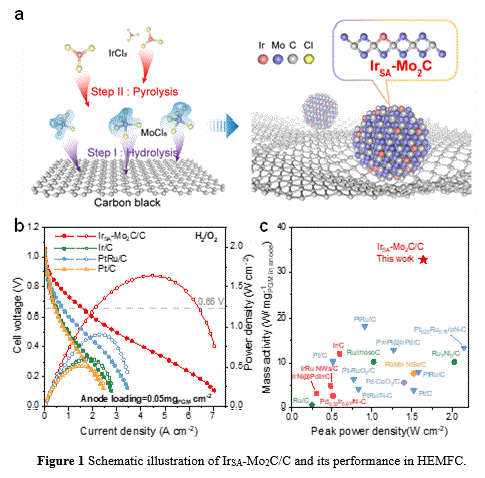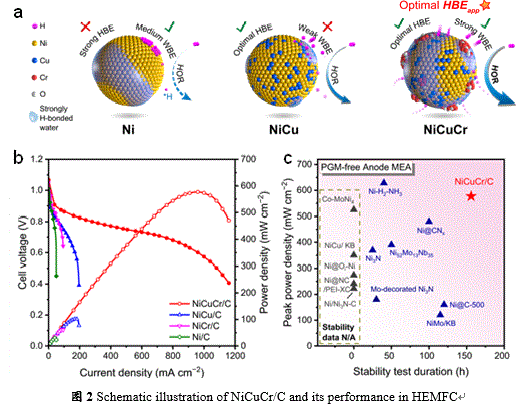Recently, the Professor Zhongbin Zhuang’ lab at the College of Chemical Engineering has made progresses in hydroxide exchange membrane fuel cells (HEMFC). Two research articles titled Atomically dispersed Iridium on Mo2C as an efficient and stable alkaline hydrogen oxidation reaction catalyst and Tuning the apparent hydrogen binding energy to achieve high-performance Ni-based hydrogen oxidation reaction catalyst are published in Nature Communications. These two studies addressed the issues of low activity and high cost of anodic catalysts in HEMFC by designing highly active and stable hydrogen oxidation catalytic materials with low usage of precious metals and non-precious metals. The studies successfully constructed high-performance HEMFCs and reduced the cost of catalysts, demonstrating significant potential for application.
Background
Utilizing hydrogen energy presents a viable solution to reduce the dependence on fossil fuels and tackle environmental concerns. Fuel cells represent an ideal way to harness hydrogen energy, as they can directly convert the chemical energy stored in hydrogen gas into electrical energy. Fuel cells boast advantages such as high efficiency, zero pollution emissions, rapid response, and low operational noise. However, the high demand for precious metal catalysts limits the widespread application of fuel cells. Recently, HEMFCs have garnered extensive attention due to their cost benefits, such as the use of affordable non-precious metal cathode catalysts and nickel-based bipolar plates. However, high-performance HEMFCs still heavily rely on precious metal catalysts. Unlike proton exchange membrane fuel cells (PEMFCs), the dependency on precious metals in HEMFCs is primarily due to the anode side. Because, the kinetics of the hydrogen oxidation reaction (HOR) catalyzed by precious metal catalysts are significantly slowed down under alkaline conditions, leading to a higher requirement for precious metals at the anode of HEMFCs. Therefore, developing efficient and stable low precious metal based or non-precious metal based alkaline HOR catalysts is key to reducing the cost of HEMFCs.
Achievement
1、Atomically dispersed Iridium as a highly efficient and stable alkaline hydrogen oxidation reaction catalyst
Single-atom catalysts have high noble metal utilization efficiency. However, carbon-based single-atom catalysts typically exhibit low HOR catalytic activity and cannot meet the anode requirements of HEMFCs. The research group utilizes the Mo2C nanoparticle as substrate to prepare atomically dispersed Ir (IrSA-Mo2C/C) due to the Pt-like band structure of Mo2C and its strong interaction with noble metals, achieving highly active and stable alkaline HOR catalysis. The specific exchange current density of IrSA-Mo2C/C for HOR is 4.1 mA cmECSA−2, which is 2.6, 7.7, and 10 times that of PtRu/C, Pt/C, and Ir/C, respectively. After 30,000 cycles of accelerated stability test, the decay of the IrSA-Mo2C/C is neglected, while the control sample exhibits significant activity decay after 10,000 cycles of testing. Benefited from the high activity of the IrSA-Mo2C/C catalyst, the anode of HEMFC only requires a low noble metal loading (0.05 mgIr cm−2). The IrSA-Mo2C/C-based HEMFC can achieve a peak power density of 1.64 W cm−2, which corresponds to an anode mass activity of 32 W mgPGM−1, surpassing the reported PGM-based anode HOR catalysts. Theoretical calculations shows that the high HOR activity is attributed to the unique Mo2C substrate, which enables the Ir site to have optimized H binding energy and moderately enhanced OH binding energy. This work significantly reduces the noble metal demand of anode in HEMFCs and lays the foundation for reducing fuel cell costs.

The first corresponding affiliation of this paper is Beijing University of Chemical Technology. Jinjie Fang, Haiyong Wang, and Qian Dang from Beijing University of Chemical Technology are the co-first authors. Professors Zhongbin Zhuang and Hui Li from Beijing niversity of Chemical Technology, and Professor Yushan Yan from the University of Delaware are the co-corresponding authors.
Link to this article, https://www.nature.com/articles/s41467-024-48672-9.
2、Highly active non-precious metal alkaline HOR catalyst based on Ni
Ni-based catalysts exhibit potential catalytic capabilities for the HOR in alkaline media. However, their activity levels fail to meet the demands for constructing high-performance HEMFC. The research group has developed a Cr2O3-modified NiCu alloy (NiCuCr/C) catalyst through a dual strategy involving the regulation of electrode components and the optimization of the interface water structure in electric double layer, achieving high activity and stability for HOR catalysis. The NiCuCr/C catalyst exhibits a specific exchange current density of 0.136 mA cmECSA−2 for HOR, surpassing almost all the currently reported non-precious metal-based HOR catalysts. Using NiCuCr/C as the anode catalyst to assemble HEMFC, a peak power density of 577 mW cm−2 can be achieved, significantly outstripping those of Ni/C (32 mW cm−2), NiCr/C (62 mW cm−2), and NiCu/C (102 mW cm−2), and surpassing most of the reported Ni-based catalysts. The NiCuCr/C -based HEMFC also exhibits excellent stability, maintaining steady operation for 156 hours during a constant potential test at 0.7 V, with an average degradation rate of merely 0.6 mA cm−2 h−1, which exceeds the performance of all Ni-based catalysts in the literature. Mechanistic investigations have indicated that the formation of a Cu-Ni alloy effectively weakens the H binding energy of Ni. While, the introduction of Cr enriches the interface with adsorbed hydroxide, which enhances the water binding at the interface. The synergistic effect of these two factors optimizes the apparent H binding energy of the catalyst and consequently accelerates the rate of the Volmer step, effectively enhancing the HOR activity. This work has improved the activity of non-precious metal anode catalysts for HEMFCs, offering a promising solution to further reduce the costs associated with fuel cells.

The first affiliation of this paper is Beijing University of Chemical Technology. Xingdong Wang, Xuerui Liu, and Jinjie Fang are the co-first authors. Professor Zhongbin Zhuang is the corresponding author.
Link to this article, https://www.nature.com/articles/s41467-024-45370-4.
